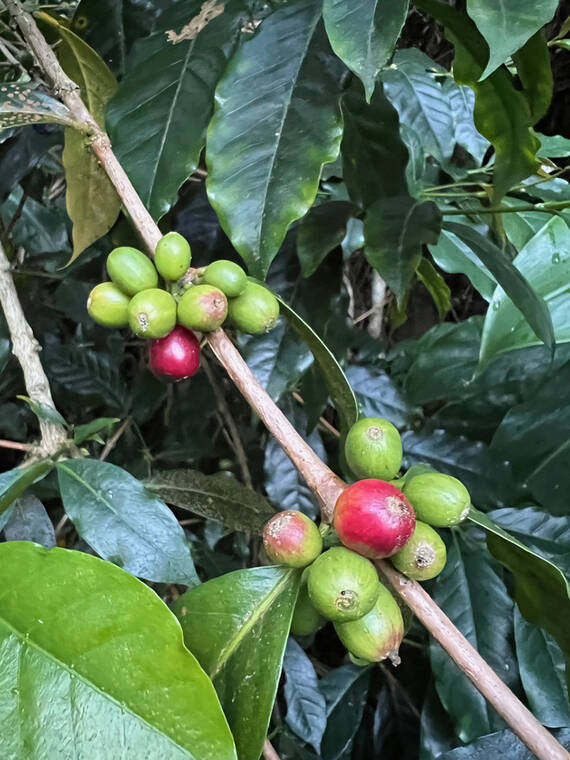This is the 51st annual Kona Coffee Cultural Festival November 4th through the 13th. There will be events all during the ten day period including farm tours, art shows, parades, educational classes like barista training and live entertainment. The grand finale will be “A Taste Of Kona” on Nov. 13 at the King Kamehameha’s Kona Beach Hotel. This will be an evening of culinary delights featuring local Island Chefs. Detailed information on all activities may be found at konacoffeefestival.org.
Coffee was introduced to Hawaii almost 200 years ago, but it thrived best in Kona where the unique climate and soils were ideal. Kona coffee has experienced a quiet birth over a century ago, growth, expansion, almost death and a rebirth that has put Kona on the map as a number one producer of top quality coffee. According to some top coffee marketers, Kona coffee is now considered to be the one of the world’s most sought after gourmet coffees. Each year the coffee festivals have been an opportunity for kamaaina and visitors to get aquainted with farmers, processors and restaurants serving our coffee. A drive through mauka Kona is a beautiful sight, especially when our coffee is in bloom or fruit. We now have more coffee grown in Kona and the state of Hawaii than at any time in years. This expansion of Kona’s coffee is not the first time we have had a boom but now that our coffee is considered gourmet, we are working together to avoid the boom and bust syndrome of the world’s coffee industry.
The Kona coffee industry was born with a few coffee trees brought over from Oahu. They were first planted in 1828 by a missionary and teacher, Samuel Ruggles. These were descendants of plants that came to Oahu from Brazil a few years earlier. During the next almost 200 years, Hawaiian coffee has had many ups and downs, but creative marketing and cooperative efforts have insured a bright future.
Coffea arabica is the species grown here exclusively. Other species of any commercial importance, but not grown here, include Coffea robusta and Coffea liberica. Examples of these and several related species may be seen at the University of Hawaii College of Tropical Agricultre and Human Resources Experiment Station in Kainaliu. Call 322-4892 to arrange a visit. The extension and research staff there has been instrumental in the success of the coffee industry.
Kona coffee is comparable to the finest of Central American mild coffees. The beans are heavy and flinty, with relatively high acidity, strong flavor, full body and fine aroma. It has been in demand as a blend, and in recent years as 100 percent pure Kona.
Although coffee can be grown in many areas of Hawaii, the Kona district is ideal. Being situated on the western leeward slopes of the central highland mass of the Big Island, it is protected from the prevailing northeast tradewinds by Mauna Loa and Hualalai volcanoes.
Coffee has a long history in Kona.It has persisted despite many adversities, overcome economic depressions, and for many decades was considered to be the economic backbone of the Kona District. Growing coffee has not been a limiting factor, since it grows wild in the understory of upland forests. The problems are the intense labor involved in pruning, fertilizing and harvesting.
For many years, local schools allowed students vacation time to help farm families harvest the crop. When this ended farm help from Central and South America came to our rescue.
The late Edward Fukunaga, a well known and respected coffee expert in Kona, pointed out to me that when he first became Kona County Agricultural Agent in September 1941, the coffee industry was in a terrible state. The farmers were deeply in debt yet world coffee prices continued falling. Debt adjustments and government relief were the order of the day. Over 1,000 acres of coffee were abandoned in 10 years following the price crash. Another 1,500 acres were to be abandoned before 1950.
Perhaps the most tragic thing that took place during the coffee depression was the exodus of the younger people from Kona. Only the aged were left to tend the farms in many families. However things perked up after the war as world coffee prices rose and farmers thrived through the fifties..
The awakening of todays vibrant and romantic coffee industry is complicated, but the key was teamwork. The concept of gourmet coffee, according to Curtis Tyler Jr. who was manager of the American Factors Coffee Mill in Kailua came up as early as the fifties, but it took years to bring the concept to fruition. Wing and Mayflower Coffee companies were the first to roast and package the highest quality Kona, but it was tourism that ultimately exposed Kona coffee to the world. Pacific Coffee Cooperative led by Mr. Yoshitaka Takashiba and Kona Farmers Cooperative managed by Les Glaspey and Bill Koepke were active in revitalizing the Kona Coffee Council. Tom Kerr, as chairman of the council, was instrumental in bringing all the diverse interests of the industry together. Today we have a new breed of coffee farmers producing world class estate coffees. Some original farms have survived the years and are thriving. Others are owned or operated by entrepreneurs from the mainland, Japan, Southeast Asia and Latin America.



